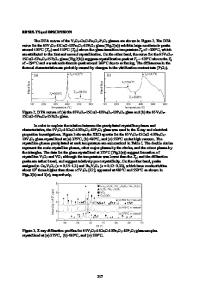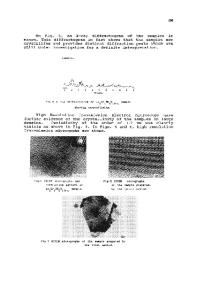Studies on Preparation, Characterization and Ammoxidation Functionality of Zirconium Phosphate-Supported V 2 O 5 Cataly
- PDF / 358,169 Bytes
- 8 Pages / 595.276 x 793.701 pts Page_size
- 114 Downloads / 349 Views
Catalysis Letters Vol. 106, Nos. 3–4, February 2006 (Ó 2006) DOI: 10.1007/s10562-005-9617-1
Studies on preparation, characterization and ammoxidation functionality of zirconium phosphate-supported V2O5 catalystsw Ch. Srilakshmi, K. Ramesh, P. Nagaraju, N. Lingaiah, and P. S. Sai Prasad* Indian Institute of Chemical Technology, Hyderabad 500 007, India
Received 30 June 2005; accepted 18 October 2005
Zirconium pyrophosphate (ZrP2O7) was synthesized from zirconyl chloride and phosphoric acid. A series of ZrP2O7-supported V2O5 catalysts, with the oxide loading ranging from 2 to 8 wt.%, was prepared by wet impregnation method. These catalysts were characterized by various techniques like X-ray diffraction, BET surface area, pore size distribution, FT-IR spectroscopy, acidity measurements and X-ray photoelectron spectroscopy. Their catalytic functionality was evaluated in the ammoxidation of 2-methyl pyrazine (MP) to 2-cyano pyrazine (CP). The V2O5/ZrP2O7 catalysts are found to be highly active and selective. FT-IR profiles of used catalysts indicate the interaction of ammonia with vanadia. The physico-chemical properties of the catalysts are correlated with their activity and nitrile selectivity. KEY WORDS: vanadia catalysts; zirconium pyrophosphate; ammoxidation of 2-methyl pyrazine; vanadium ammonium complex.
1. Introduction In the recent past, metal phosphates have attracted considerable attention as solid acid catalysts [1–5]. The activity of these materials is attributed to the Bronsted acidity of hydroxyl groups and the Lewis acidity of the metal centre. In particular, zirconium phosphates have been used in catalytic reactions such as dehydration of alcohols and isomerization of olefins [6–10]. Owing to their textural and acid properties these are also used as supports for other catalytically active inorganic species [11]. Supported vanadium oxides form an industrially important class of active catalysts. They have been studied quite extensively because of their use in several processes [12–19]. Generally, bulk V2O5 cannot be used as a catalyst due to its poor thermal stability and mechanical strength and low active surface area. Therefore, vanadium oxide is normally supported on different carriers depending on the type of reaction to be catalysed. Various single oxides such as Al2O3, TiO2, SiO2 are commonly employed as supports for dispersing vanadium oxide. Metal oxide-supported vanadia catalysts particularly find application in the ammoxidation of aromatic hydrocarbons to their corresponding nitriles [20–22]. With respect to metal phosphate, vanadia supported on layered titanium phosphate has been used as a catalyst for the oxidation of o-xylene, showing reasonable partial oxidation property [5,23]. The ammoxidation of MP is a reaction of recent interest since the CP produced is further transformed to 2-
amidopyrazine (popularly called as pyrazinamide, an anti-tubercular drug). It has been observed that the most frequently used commercial vanadia-based catalysts, for example V/Sb and V/Ti, are highly active. Th
Data Loading...











